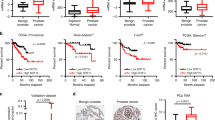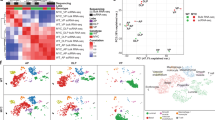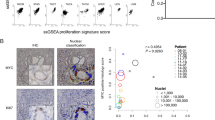Abstract
The histone demethylase JMJD1A, which controls gene expression by epigenetic regulation of H3K9 methylation marks, functions in diverse activities, including spermatogenesis, metabolism and stem cell self-renewal and differentiation. Here, we found that JMJD1A knockdown in prostate cancer cells antagonizes their proliferation and survival. Profiling array analyses revealed that JMJD1A-dependent genes function in cellular growth, proliferation and survival, and implicated that the c-Myc transcriptional network is deregulated following JMJD1A inhibition. Biochemical analyses confirmed that JMJD1A enhances c-Myc transcriptional activity by upregulating c-Myc expression levels. Mechanistically, JMJD1A activity promoted recruitment of androgen receptor (AR) to the c-Myc gene enhancer and induced H3K9 demethylation, increasing AR-dependent transcription of c-Myc mRNA. In parallel, we found that JMJD1A regulated c-Myc stability, likely by inhibiting HUWE1, an E3 ubiquitin ligase known to target degradation of several substrates including c-Myc. JMJD1A (wild type or mutant lacking histone demethylase activity) bound to HUWE1, attenuated HUWE1-dependent ubiquitination and subsequent degradation of c-Myc, increasing c-Myc protein levels. Furthermore, c-Myc knockdown in prostate cancer cells phenocopied effects of JMJD1A knockdown, and c-Myc re-expression in JMJD1A-knockdown cells partially rescued prostate cancer cell growth in vitro and in vivo. c-Myc protein levels were positively correlated with those of JMJD1A in a subset of human prostate cancer specimens. Collectively, our findings identify a critical role for JMJD1A in regulating proliferation and survival of prostate cancer cells by controlling c-Myc expression at transcriptional and post-translational levels.
This is a preview of subscription content, access via your institution
Access options
Subscribe to this journal
Receive 50 print issues and online access
$259.00 per year
only $5.18 per issue
Buy this article
- Purchase on Springer Link
- Instant access to full article PDF
Prices may be subject to local taxes which are calculated during checkout






Similar content being viewed by others
References
Yamane K, Toumazou C, Tsukada Y, Erdjument-Bromage H, Tempst P, Wong J et al. JHDM2A, a JmjC-containing H3K9 demethylase, facilitates transcription activation by androgen receptor. Cell 2006; 125: 483–495.
Goda S, Isagawa T, Chikaoka Y, Kawamura T, Aburatani H . Control of histone H3 lysine 9 (H3K9) methylation state via cooperative two-step demethylation by Jumonji domain containing 1A (JMJD1A) homodimer. J Biol Chem 2013; 288: 36948–36956.
Kuroki S, Matoba S, Akiyoshi M, Matsumura Y, Miyachi H, Mise N et al. Epigenetic regulation of mouse sex determination by the histone demethylase Jmjd1a. Science 2013; 341: 1106–1109.
Tateishi K, Okada Y, Kallin EM, Zhang Y . Role of Jhdm2a in regulating metabolic gene expression and obesity resistance. Nature 2009; 458: 757–761.
Okada Y, Scott G, Ray MK, Mishina Y, Zhang Y . Histone demethylase JHDM2A is critical for Tnp1 and Prm1 transcription and spermatogenesis. Nature 2007; 450: 119–123.
Loh YH, Zhang W, Chen X, George J, Ng HH . Jmjd1a and Jmjd2c histone H3 Lys 9 demethylases regulate self-renewal in embryonic stem cells. Genes Dev 2007; 21: 2545–2557.
Siegel R, Naishadham D, Jemal A . Cancer statistics, 2012. CA Cancer J Clin 2012; 62: 10–29.
Mitsiades N . A road map to comprehensive androgen receptor axis targeting for castration-resistant prostate cancer. Cancer Res 2013; 73: 4599–4605.
Sharma NL, Massie CE, Ramos-Montoya A, Zecchini V, Scott HE, Lamb AD et al. The androgen receptor induces a distinct transcriptional program in castration-resistant prostate cancer in man. Cancer Cell 2013; 23: 35–47.
Cai C, He HH, Chen S, Coleman I, Wang H, Fang Z et al. Androgen receptor gene expression in prostate cancer is directly suppressed by the androgen receptor through recruitment of lysine-specific demethylase 1. Cancer Cell 2011; 20: 457–471.
Qi J, Nakayama K, Cardiff RD, Borowsky AD, Kaul K, Williams R et al. Siah2-dependent concerted activity of HIF and FoxA2 regulates formation of neuroendocrine phenotype and neuroendocrine prostate tumors. Cancer Cell 2010; 18: 23–38.
Parimi V, Goyal R, Poropatich K, Yang XJ . Neuroendocrine differentiation of prostate cancer: a review. Am J Clin Exp Urol [Review] 2014; 2: 273–285.
Krieg AJ, Rankin EB, Chan D, Razorenova O, Fernandez S, Giaccia AJ . Regulation of the histone demethylase JMJD1A by hypoxia-inducible factor 1 alpha enhances hypoxic gene expression and tumor growth. Mol Cell Biol 2010; 30: 344–353.
Tee AE, Ling D, Nelson C, Atmadibrata B, Dinger ME, Xu N et al. The histone demethylase JMJD1A induces cell migration and invasion by up-regulating the expression of the long noncoding RNA MALAT1. Oncotarget 2014; 5: 1793–1804.
Park SJ, Kim JG, Son TG, Yi JM, Kim ND, Yang K et al. The histone demethylase JMJD1A regulates adrenomedullin-mediated cell proliferation in hepatocellular carcinoma under hypoxia. Biochem Biophys Res Commun 2013; 434: 722–727.
Parrish JK, Sechler M, Winn RA, Jedlicka P . The histone demethylase KDM3A is a microRNA-22-regulated tumor promoter in Ewing Sarcoma. Oncogene 2015; 34: 257–262.
Osawa T, Tsuchida R, Muramatsu M, Shimamura T, Wang F, Suehiro J et al. Inhibition of histone demethylase JMJD1A improves anti-angiogenic therapy and reduces tumor-associated macrophages. Cancer Res 2013; 73: 3019–3028.
Dang CV . MYC on the path to cancer. Cell 2012; 149: 22–35.
Gil J, Kerai P, Lleonart M, Bernard D, Cigudosa JC, Peters G et al. Immortalization of primary human prostate epithelial cells by c-Myc. Cancer Res 2005; 65: 2179–2185.
Ellwood-Yen K, Graeber TG, Wongvipat J, Iruela-Arispe ML, Zhang J, Matusik R et al. Myc-driven murine prostate cancer shares molecular features with human prostate tumors. Cancer Cell 2003; 4: 223–238.
Cho H, Herzka T, Zheng W, Qi J, Wilkinson JE, Bradner JE et al. RapidCaP, a novel GEM model for metastatic prostate cancer analysis and therapy, reveals myc as a driver of Pten-mutant metastasis. Cancer Discov 2014; 4: 318–333.
Wang J, Kobayashi T, Floc'h N, Kinkade CW, Aytes A, Dankort D et al. B-Raf activation cooperates with PTEN loss to drive c-Myc expression in advanced prostate cancer. Cancer Res 2012; 72: 4765–4776.
Kim J, Roh M, Doubinskaia I, Algarroba GN, Eltoum IE, Abdulkadir SA . A mouse model of heterogeneous, c-MYC-initiated prostate cancer with loss of Pten and p53. Oncogene 2012; 31: 322–332.
Hawksworth D, Ravindranath L, Chen Y, Furusato B, Sesterhenn IA, McLeod DG et al. Overexpression of C-MYC oncogene in prostate cancer predicts biochemical recurrence. Prostate Cancer Prostatic Dis 2010; 13: 311–315.
Rye MB, Bertilsson H, Drablos F, Angelsen A, Bathen TF, Tessem MB . Gene signatures ESC, MYC and ERG-fusion are early markers of a potentially dangerous subtype of prostate cancer. BMC Med Genomics 2014; 7: 50.
Gurel B, Iwata T, Koh CM, Jenkins RB, Lan F, Van Dang C et al. Nuclear MYC protein overexpression is an early alteration in human prostate carcinogenesis. Mod Pathol 2008; 21: 1156–1167.
Koh CM, Bieberich CJ, Dang CV, Nelson WG, Yegnasubramanian S, De Marzo AM . MYC and prostate cancer. Genes Cancer 2010; 1: 617–628.
Taylor BS, Schultz N, Hieronymus H, Gopalan A, Xiao Y, Carver BS et al. Integrative genomic profiling of human prostate cancer. Cancer Cell 2010; 18: 11–22.
Sotelo J, Esposito D, Duhagon MA, Banfield K, Mehalko J, Liao H et al. Long-range enhancers on 8q24 regulate c-Myc. Proc Natl Acad Sci USA 2010; 107: 3001–3005.
Wang L, Liu R, Li W, Chen C, Katoh H, Chen GY et al. Somatic single hits inactivate the X-linked tumor suppressor FOXP3 in the prostate. Cancer Cell 2009; 16: 336–346.
Chen D, Kon N, Li M, Zhang W, Qin J, Gu W . ARF-BP1/Mule is a critical mediator of the ARF tumor suppressor. Cell 2005; 121: 1071–1083.
Wang X, Lu G, Li L, Yi J, Yan K, Wang Y et al. HUWE1 interacts with BRCA1 and promotes its degradation in the ubiquitin-proteasome pathway. Biochem Biophys Res Commun 2014; 444: 549–554.
Zhong Q, Gao W, Du F, Wang X . Mule/ARF-BP1, a BH3-only E3 ubiquitin ligase, catalyzes the polyubiquitination of Mcl-1 and regulates apoptosis. Cell 2005; 121: 1085–1095.
Vaughan L, Tan CT, Chapman A, Nonaka D, Mack NA, Smith D et al. HUWE1 ubiquitylates and degrades the RAC activator TIAM1 promoting cell-cell adhesion disassembly, migration, and invasion. Cell Rep 2015; 10: 88–102.
Zhao X, Heng JI, Guardavaccaro D, Jiang R, Pagano M, Guillemot F et al. The HECT-domain ubiquitin ligase Huwe1 controls neural differentiation and proliferation by destabilizing the N-Myc oncoprotein. Nat Cell Biol 2008; 10: 643–653.
Inoue S, Hao Z, Elia AJ, Cescon D, Zhou L, Silvester J et al. Mule/Huwe1/Arf-BP1 suppresses Ras-driven tumorigenesis by preventing c-Myc/Miz1-mediated down-regulation of p21 and p15. Genes Dev 2013; 27: 1101–1114.
Rajasekhar VK, Studer L, Gerald W, Socci ND, Scher HI . Tumour-initiating stem-like cells in human prostate cancer exhibit increased NF-kappaB signalling. Nat Commun 2011; 2: 162.
Grasso CS, Wu YM, Robinson DR, Cao X, Dhanasekaran SM, Khan AP et al. The mutational landscape of lethal castration-resistant prostate cancer. Nature 2012; 487: 239–243.
Zhou Z, Corden JL, Brown TR . Identification and characterization of a novel androgen response element composed of a direct repeat. J Biol Chem 1997; 272: 8227–8235.
Tao S, He H, Chen Q . ChIP-seq analysis of androgen receptor in LNCaP cell line. Mol Biol Rep 2014; 41: 6291–6296.
Herkert B, Eilers M . Transcriptional repression: the dark side of myc. Genes Cancer 2010; 1: 580–586.
Bush A, Mateyak M, Dugan K, Obaya A, Adachi S, Sedivy J et al. c-myc null cells misregulate cad and gadd45 but not other proposed c-Myc targets. Genes Dev 1998; 12: 3797–3802.
Conzen SD, Gottlob K, Kandel ES, Khanduri P, Wagner AJ, O'Leary M et al. Induction of cell cycle progression and acceleration of apoptosis are two separable functions of c-Myc: transrepression correlates with acceleration of apoptosis. Mol Cell Biol 2000; 20: 6008–6018.
Gao L, Schwartzman J, Gibbs A, Lisac R, Kleinschmidt R, Wilmot B et al. Androgen receptor promotes ligand-independent prostate cancer progression through c-Myc upregulation. PLoS One 2013; 8: e63563.
Mimura I, Nangaku M, Kanki Y, Tsutsumi S, Inoue T, Kohro T et al. Dynamic change of chromatin conformation in response to hypoxia enhances the expression of GLUT3 (SLC2A3) by cooperative interaction of hypoxia-inducible factor 1 and KDM3A. Mol Cell Biol 2012; 32: 3018–3032.
Ouyang X, Jessen WJ, Al-Ahmadie H, Serio AM, Lin Y, Shih WJ et al. Activator protein-1 transcription factors are associated with progression and recurrence of prostate cancer. Cancer Res 2008; 68: 2132–2144.
Chen SY, Cai C, Fisher CJ, Zheng Z, Omwancha J, Hsieh CL et al. c-Jun enhancement of androgen receptor transactivation is associated with prostate cancer cell proliferation. Oncogene 2006; 25: 7212–7223.
Civenni G, Malek A, Albino D, Garcia-Escudero R, Napoli S, Di Marco S et al. RNAi-mediated silencing of Myc transcription inhibits stem-like cell maintenance and tumorigenicity in prostate cancer. Cancer Res 2013; 73: 6816–6827.
Yu C, Yao Z, Dai J, Zhang H, Escara-Wilke J, Zhang X et al. ALDH activity indicates increased tumorigenic cells, but not cancer stem cells, in prostate cancer cell lines. In Vivo 2011; 25: 69–76.
Acknowledgements
We thank Dr Ze’ev Ronai and members of the Ronai Lab for helpful discussions. We thank Dr Yi Zhang for the human JMJD1A expression plasmids, Dr Genze Shao for the GFP-HUWE1 expression plasmids, Dr William Tansey for the c-Myc expression plasmid and Dr Ze’ev Ronai for the p53 expression plasmid and 5XTRE luciferase reporter. Support by NCI Grant CA154888 (to JQ) and a Merit Review Award Department of Veterans Affairs (to AH) is gratefully acknowledged.
Author information
Authors and Affiliations
Corresponding author
Ethics declarations
Competing interests
The authors declare no conflict of interest.
Additional information
Supplementary Information accompanies this paper on the Oncogene website
Supplementary information
Rights and permissions
About this article
Cite this article
Fan, L., Peng, G., Sahgal, N. et al. Regulation of c-Myc expression by the histone demethylase JMJD1A is essential for prostate cancer cell growth and survival. Oncogene 35, 2441–2452 (2016). https://doi.org/10.1038/onc.2015.309
Received:
Revised:
Accepted:
Published:
Issue Date:
DOI: https://doi.org/10.1038/onc.2015.309
This article is cited by
-
Androgen drives melanoma invasiveness and metastatic spread by inducing tumorigenic fucosylation
Nature Communications (2024)
-
SLC39A10 promotes malignant phenotypes of gastric cancer cells by activating the CK2-mediated MAPK/ERK and PI3K/AKT pathways
Experimental & Molecular Medicine (2023)
-
KDM3A-mediated SP1 activates PFKFB4 transcription to promote aerobic glycolysis in osteosarcoma and augment tumor development
BMC Cancer (2022)
-
Receptor-interacting protein kinase 2 (RIPK2) stabilizes c-Myc and is a therapeutic target in prostate cancer metastasis
Nature Communications (2022)
-
Downregulation of miR-335 exhibited an oncogenic effect via promoting KDM3A/YAP1 networks in clear cell renal cell carcinoma
Cancer Gene Therapy (2022)



